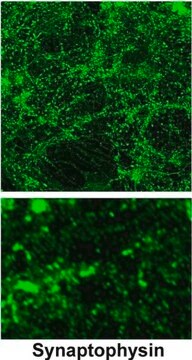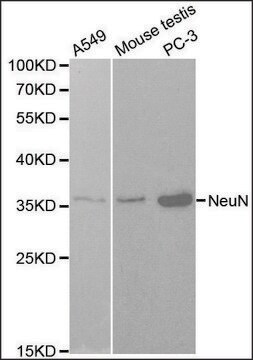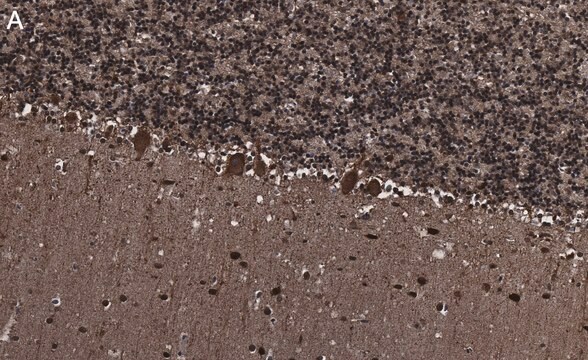MAB5258-I
Anti-Synaptophysin Antibody, clone SY38
clone SY38, from mouse
Synonym(s):
Synaptophysin, Major synaptic vesicle protein p38
About This Item
IF
IHC
WB
immunofluorescence: suitable
immunohistochemistry: suitable (paraffin)
western blot: suitable
Recommended Products
biological source
mouse
Quality Level
antibody form
purified immunoglobulin
antibody product type
primary antibodies
clone
SY38, monoclonal
species reactivity
bovine, mouse, rat, human
technique(s)
immunocytochemistry: suitable
immunofluorescence: suitable
immunohistochemistry: suitable (paraffin)
western blot: suitable
isotype
IgG1κ
NCBI accession no.
UniProt accession no.
shipped in
ambient
target post-translational modification
unmodified
Gene Information
human ... SYP(6855)
General description
Specificity
Immunogen
Application
Western Blotting Analysis: A 1:1,000 dilution from a representative lot detected Synaptophysin in 10 µg of rat hippocampus and human whole brain tissue lysates.
Immunocytochemistry Analysis: Representative lots immunostained presynaptic vesicles of 4% formaldehyde-fxied, 0.2% Triton X-100-permeabilzied primary mouse hippocampal neurons by fluorescent immunocytochemistry (Hu, X., et al. (2008). J. Neurosci. 28(49):13094-13105; Tarr, P.T., and Edwards, P.A. (2008). J. Lipid Res. 49(1):169-182).
Immunofluorescence Analysis: A representative lot immunostained presynaptic membrane of neurons by fluorescent immunohistochemistry staining of 4% paraformaldehyde-fixed, 0.3% Triton X-100-permeabilized, OCT-embedded rat spinal cord cryosections (Stück, E.D., et al. (2012). Neural Plast. 2012:261345).
Immunofluorescence Analysis: A representative lot immunostained synaptophysin around a large neuron in the ventral horn of the lumbar (L3/L4) segment by fluorescent immunohistochemistry staining of 2% paraformaldehyde/0.2% parabenzoquinone-fixed free-floating rat spinal cord sections (Macias, M., et al. (2009). BMC Neurosci. 10:144).
Immunofluorescence Analysis: A representative lot immunostained synaptophysin in bovine (pancreas) and human (pancreas, pheochromocytoma, and islet-cell carcinoma) frozen tissue sections (Wiedenmann, B., et al. (1986). Proc. Natl. Acad. Sci. U.S.A. 83(10):3500-3504).
Western Blotting Analysis: A representative lot detected an upregulated synaptophysin expression in human iPSCs with a 4-bp deletion in DISC1 gene (Wen, Z., et al. (2014). Nature. 515(7527):414-418).
Western Blotting Analysis: A representative lot detected synaptophysin distribution among PC12 rat pheochromocytoma cell membrane fractions (Salazar, G., et al. (2005). Mol. Biol. Cell. 16(8):3692-3704).
Western Blotting Analysis: A representative lot detected only synaptophysin recombinant contructs that contained the flexible segment -SGGGG- in the center of the c-terminal pentapeptide repeats (Knaus, P., and Betz, H. (1990). FEBS Lett. 261(2):358-360).
Neuroscience
Quality
Western Blotting Analysis: A 1:1,000 dilution of this antibody detected Synaptophysin in 10 µg of mouse hypothalamus tissue lysate.
Target description
Physical form
Storage and Stability
Other Notes
Disclaimer
Not finding the right product?
Try our Product Selector Tool.
recommended
Storage Class Code
12 - Non Combustible Liquids
WGK
WGK 1
Certificates of Analysis (COA)
Search for Certificates of Analysis (COA) by entering the products Lot/Batch Number. Lot and Batch Numbers can be found on a product’s label following the words ‘Lot’ or ‘Batch’.
Already Own This Product?
Find documentation for the products that you have recently purchased in the Document Library.
Our team of scientists has experience in all areas of research including Life Science, Material Science, Chemical Synthesis, Chromatography, Analytical and many others.
Contact Technical Service



